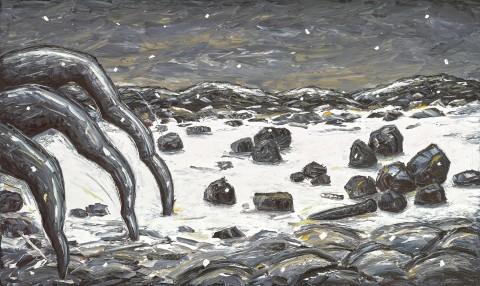UNTITLED, 2007
PETER BOOTH
oil on linen
117.0 x 198.0 cm
signed and dated verso: BOOTH 2007
Anna Schwartz Gallery, Melbourne (label attached on stretcher bar verso)
Shannon Bennett, Melbourne, acquired from the above in 2008
probably: Peter Booth, 21st Century, Anna Schwartz Gallery, Melbourne, 8 – 31 May 2008
A key figure in the revival of figurative painting in Melbourne in the 1980s, Booth’s reputation as one of Australia’s most renowned contemporary painters was cemented in the early years of that decade when he was chosen (alongside Rosalie Gascoigne) to represent Australia at the Venice Biennale in 1982. Over the intervening decades since, he has only continued to attract further widespread acclaim with his highly expressive, energetic works which, depicting a world both imagined and observed, poignantly explore fundamental human emotions and anxieties; issues of spiritual turmoil; social alienation and the devolution of civilisation. Drawing upon epic legends of the past and prophecies for an imagined future, thus Booth's vision transcends the immediate or particular to acquire a universality comparable to the musings of his greatest artistic predecessors, including Goya, Blake and Shakespeare.
In the winter of 1989, Booth first embarked upon what were to become his celebrated 'snow paintings'. Influenced partly by his childhood years in Sheffield in England's industrial north, these works represented an important transition in the artist’s oeuvre which he paralleled to the journey in Milton's epic sequence of poems, Paradise Lost (1667) to Paradise Regained (1671). More specifically however, the series was inspired by the artist's re-reading of Shakespeare's Macbeth (1606) with its chilling themes of ambition and evil bearing resonance for Booth in contemporary Western greed and its blatant disregard for the planet. Accordingly, in many of these paintings, snow throws a white curtain of silence over a charred and blackened landscape, heralding the end of man's aggression towards his fellow man and the environment, like the omen of destruction foretold by the decimation of the Birnam wood in Macbeth.
Like these earlier works blanketed in snow, Untitled, 2007 here similarly presents almost as a stage set for a performance whose commencement is imminent, or possibly only just ended. Empty of figures, the composition is overwhelmed by an eerie and profound silence, populated only by vestiges of buildings or rocks, and a disconcertingly oversized claw encroaching on the left – perhaps alluding to emergence of a mutant society after the collapse of human civilisation. Indeed, writing in the introduction to the catalogue accompanying Booth’s exhibition ‘21st Century’, held at Anna Schwartz Gallery in 2008 (in which the present work was most likely featured), Justin Clemens elaborates upon this apocalyptic theme, albeit from a more philosophical perspective:
‘How did you end up in this mess? Who’s to blame? How are you going to get out of here? There has to be some way of explaining all this uncertainty, but you wouldn’t know who to ask. Even if you did, you wouldn’t trust them if they told you… It’s the postmodern condition… The death of metanarratives, multiple voices, heterogeneity beyond belief, unrepresentable futures, risk, uncertainty, world-historical nihilism… In fact, it’s those modernist obsessions with theory, method, new ways of doing things, that got us into this Gen-Existential Crisis in the first place… No gods, no masters. Isn’t that the problem, though? No one to believe, no one to obey… The environment’s stuffed. Love’s stuffed… Politics is stuffed.’1
Yet, to focus solely upon the immediate pessimistic impact of such works is to ignore the lyricism – even optimism – frequently underlying Booth’s imagery; as Jason Smith reiterates, '…for Booth, the winter landscape is one of serenity and the promise of renewal. It reminds us of the resilience of nature and is a metaphor for human endurance against the physical and psychological trials of life.’2
1. Clemens, J., ‘Introduction’, Peter Booth: 21st Century, Anna Schwartz Gallery, Melbourne, 2008, n.p.
2. Smith, J., 'Peter Booth: Human / Nature', in Peter Booth: Human / Nature, National Gallery of Victoria, Melbourne, 2003, pp. 14 – 15
VERONICA ANGELATOS
